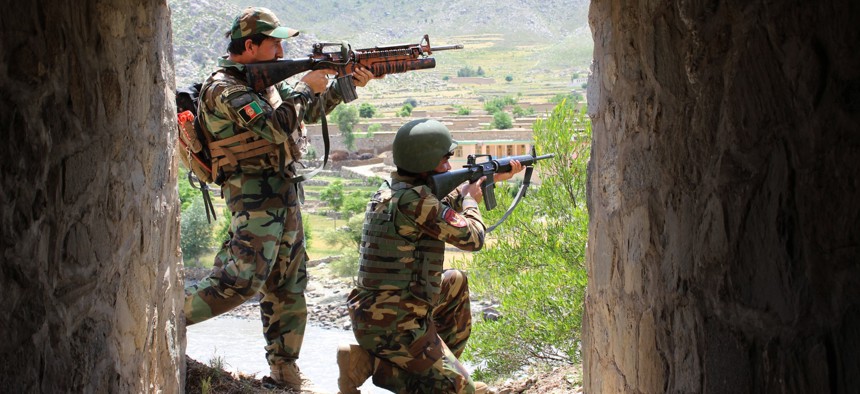MARK KIMMITT

The rout of the Afghan National Defense and Security Forces, or ANDSF, will go down in history as one of the greatest military defeats of the past century. Like the Iraqi Security Forces in 2014 and the French Army in 1940, these forces melted away in the face of numerically inferior forces and—France excepted—forces equipped with far inferior equipment. By any quantifiable measure, these armies should have easily held off the Taliban, ISIS, and the German Army. Instead, the French Army collapsed in seven weeks, the Iraqi Security Forces evaporated from the battlefield within days of the ISIS attack from Syria, and the recent Taliban offensive took less than eight days from the capture of Kunduz to the capitulation of Kabul.
It was not supposed to be this way. As recently as last month, President Biden noted that the Afghan armed forces were “as well equipped as any army in the world” and “the likelihood there’s going to be the Taliban overrunning everything and owning the whole country is highly unlikely.” The ANDSF were well equipped, numerically superior and superbly trained over the past two decades by the United States, NATO and its coalition allies. Billions of dollars were spent to train and equip hundreds of thousands of soldiers with modern weapons and aircraft.
Four reasons stand out for the collapse: the “hasty withdrawal,” the lack of a cause worth the sacrifice, pervasive corruption, and—perhaps least appreciated—the Taliban information operations.
Little doubt the “hasty withdrawal” contributed to the debacle, a withdrawal that was supposed to be safe and seamless. At his July 8 press conference, President Biden saw a swift departure as a virtue. “We need[ed] to move swiftly to conduct the main elements of the drawdown” he said. “And in this context, speed is safety.” In its place, the U.S. pledged to provide “over the horizon” close air, logistics, and maintenance support but questions arise whether this support was in place when the major offensive began. Presciently, Joe Votel —who led U.S. Central Command for several years—had said in May, “Whatever support we’re prepared to provide over the horizon, we need to be prepared” as “the Taliban will test the Afghan security forces very early on.” There is little evidence that the over-the-horizon air support had any effect in recent weeks, and plenty of evidence that the pullout of contractors hampered everything from maintaining ANDSF aircraft to delivering supplies.
One aspect of the collapse that has gone underdiscussed is the Taliban’s deft use of information operations. While many of the world’s armies struggle with this concept, the Taliban have mastered the core elements of public relations, psychological operations, and propaganda. Its brilliant public relations campaigners created sophisticated propaganda for its own forces, talking about inevitable victory, focusing on “messages to its soldiers and…maintaining unity among them by reminding them of their continuous series of conquests.” For the broader world, they have conducted an “image offensive” to convince the world of a more moderate “Taliban 2.0.” And against the ANDSF, they have been running an equally successful psyops operation to persuade large number of Afghan units to surrender or withdraw from the battlefield. Many commanders “just surrendered in return for amnesty, which the Taliban granted them and let them go home.”
But a hasty withdrawal alone does not explain why ANDSF soldiers won’t fight. At unit level, soldiers fight for each other, and they fight for a cause. While hundreds of thousands of Taliban have died over the decades, its fighters remain fused together by a powerful cause which portrays them as modern-day puritans, linked by the powerful forces of religion, tribal loyalty and, in recent years, hate for the U.S.-backed government in Kabul. By contrast, one wonders what cause the Afghan troops fought for. As Medal of Honor winner Col. Jack Jacobs has noted, “Without a cause, it is impossible to motivate people to fight, and a cause is essential.”
A cause is even more suspect when one operates within an environment of endemic corruption, and the ANDSF perfected the art. Poor logistics, ghost soldiers, corrupt leaders embezzling the pay of individual soldiers, commanders appointed for their political connections and noted for their incompetence—pervasive corruption within the ANDSF destroyed morale within units and among individuals.
There will be other factors cited to explain the extraordinary collapse of the ANDSF. Attempting to build an American-style Army in a third-world country, an unwillingness to sacrifice for a corrupt government, military service that was little more than a jobs program and a paycheck are but a few. Other studies will ask the question of how the international community could spend so much to man, train and equip the Afghan security forces and get so little. For both questions, the answer may be found on a monument in a corner of Arlington cemetery which states. “Not for fame or reward, not lured by place or for rank, or goaded by necessity, but in simple obedience to duty as they understand it, these men suffered all, sacrificed all, dared all, and died.” You can a pay a soldier’s salary, conduct the best training and provide the most modern equipment, but you can’t create commitment and you can’t buy a cause.
No comments:
Post a Comment